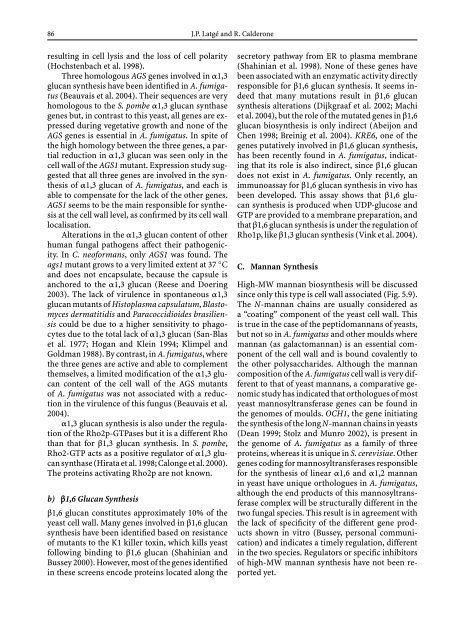Growth, Differentiation and Sexuality
Growth, Differentiation and Sexuality
Growth, Differentiation and Sexuality
Create successful ePaper yourself
Turn your PDF publications into a flip-book with our unique Google optimized e-Paper software.
86 J.P. Latgé <strong>and</strong> R. Calderone<br />
resulting in cell lysis <strong>and</strong> the loss of cell polarity<br />
(Hochstenbach et al. 1998).<br />
Three homologous AGS genes involved in α1,3<br />
glucan synthesis have been identified in A. fumigatus<br />
(Beauvais et al. 2004). Their sequences are very<br />
homologous to the S. pombe α1,3 glucan synthase<br />
genes but, in contrast to this yeast, all genes are expressed<br />
during vegetative growth <strong>and</strong> none of the<br />
AGS genes is essential in A. fumigatus. Inspiteof<br />
the high homology between the three genes, a partial<br />
reduction in α1,3 glucan was seen only in the<br />
cell wall of the AGS1 mutant. Expression study suggested<br />
that all three genes are involved in the synthesis<br />
of α1,3 glucan of A. fumigatus, <strong>and</strong> each is<br />
able to compensate for the lack of the other genes.<br />
AGS1 seems to be the main responsible for synthesis<br />
at the cell wall level, as confirmed by its cell wall<br />
localisation.<br />
Alterations in the α1,3 glucan content of other<br />
human fungal pathogens affect their pathogenicity.<br />
In C. neoformans, only AGS1 was found. The<br />
ags1 mutant grows to a very limited extent at 37 ◦ C<br />
<strong>and</strong> does not encapsulate, because the capsule is<br />
anchored to the α1,3 glucan (Reese <strong>and</strong> Doering<br />
2003). The lack of virulence in spontaneous α1,3<br />
glucan mutants of Histoplasma capsulatum, Blastomyces<br />
dermatitidis <strong>and</strong> Paracoccidioides brasiliensis<br />
could be due to a higher sensitivity to phagocytes<br />
due to the total lack of α1,3 glucan (San-Blas<br />
et al. 1977; Hogan <strong>and</strong> Klein 1994; Klimpel <strong>and</strong><br />
Goldman 1988). By contrast, in A. fumigatus,where<br />
the three genes are active <strong>and</strong> able to complement<br />
themselves, a limited modification of the α1,3 glucan<br />
content of the cell wall of the AGS mutants<br />
of A. fumigatus was not associated with a reduction<br />
in the virulence of this fungus (Beauvais et al.<br />
2004).<br />
α1,3 glucan synthesis is also under the regulationoftheRho2p-GTPasesbutitisadifferentRho<br />
than that for β1,3 glucan synthesis. In S. pombe,<br />
Rho2-GTP acts as a positive regulator of α1,3 glucan<br />
synthase (Hirata et al. 1998; Calonge et al. 2000).<br />
The proteins activating Rho2p are not known.<br />
b) β1,6 Glucan Synthesis<br />
β1,6 glucan constitutes approximately 10% of the<br />
yeast cell wall. Many genes involved in β1,6 glucan<br />
synthesis have been identified based on resistance<br />
of mutants to the K1 killer toxin, which kills yeast<br />
following binding to β1,6 glucan (Shahinian <strong>and</strong><br />
Bussey 2000). However, most of the genes identified<br />
in these screens encode proteins located along the<br />
secretory pathway from ER to plasma membrane<br />
(Shahinian et al. 1998). None of these genes have<br />
been associated with an enzymatic activity directly<br />
responsible for β1,6 glucan synthesis. It seems indeed<br />
that many mutations result in β1,6 glucan<br />
synthesis alterations (Dijkgraaf et al. 2002; Machi<br />
et al. 2004), but the role of the mutated genes in β1,6<br />
glucan biosynthesis is only indirect (Abeijon <strong>and</strong><br />
Chen 1998; Breinig et al. 2004). KRE6, oneofthe<br />
genes putatively involved in β1,6 glucan synthesis,<br />
has been recently found in A. fumigatus, indicating<br />
that its role is also indirect, since β1,6 glucan<br />
does not exist in A. fumigatus. Onlyrecently,an<br />
immunoassay for β1,6 glucan synthesis in vivo has<br />
been developed. This assay shows that β1,6 glucan<br />
synthesis is produced when UDP-glucose <strong>and</strong><br />
GTP are provided to a membrane preparation, <strong>and</strong><br />
that β1,6 glucan synthesis is under the regulation of<br />
Rho1p, like β1,3 glucan synthesis (Vink et al. 2004).<br />
C. Mannan Synthesis<br />
High-MW mannan biosynthesis will be discussed<br />
sinceonlythistypeiscellwallassociated(Fig.5.9).<br />
The N-mannan chains are usually considered as<br />
a “coating” component of the yeast cell wall. This<br />
is true in the case of the peptidomannans of yeasts,<br />
butnotsoinA. fumigatus <strong>and</strong> other moulds where<br />
mannan (as galactomannan) is an essential component<br />
of the cell wall <strong>and</strong> is bound covalently to<br />
the other polysaccharides. Although the mannan<br />
composition of the A. fumigatus cellwallisverydifferent<br />
to that of yeast mannans, a comparative genomic<br />
study has indicated that orthologues of most<br />
yeast mannosyltransferase genes can be found in<br />
the genomes of moulds. OCH1, the gene initiating<br />
the synthesis of the long N-mannan chains in yeasts<br />
(Dean 1999; Stolz <strong>and</strong> Munro 2002), is present in<br />
the genome of A. fumigatus as a family of three<br />
proteins, whereas it is unique in S. cerevisiae.Other<br />
genes coding for mannosyltransferases responsible<br />
for the synthesis of linear α1,6 <strong>and</strong> α1,2 mannan<br />
in yeast have unique orthologues in A. fumigatus,<br />
although the end products of this mannosyltransferase<br />
complex will be structurally different in the<br />
two fungal species. This result is in agreement with<br />
the lack of specificity of the different gene products<br />
shown in vitro (Bussey, personal communication)<br />
<strong>and</strong> indicates a timely regulation, different<br />
in the two species. Regulators or specific inhibitors<br />
of high-MW mannan synthesis have not been reported<br />
yet.

















